Byzantine Government › Similarities Between Eastern & Western Philosophy » Origins and History
Articles and Definitions › Contents
- Byzantine Government › Ancient History
- Similarities Between Eastern & Western Philosophy › Ancient History
Ancient civilizations › Historical places, and their characters
Byzantine Government › Ancient History
Definition and Origins
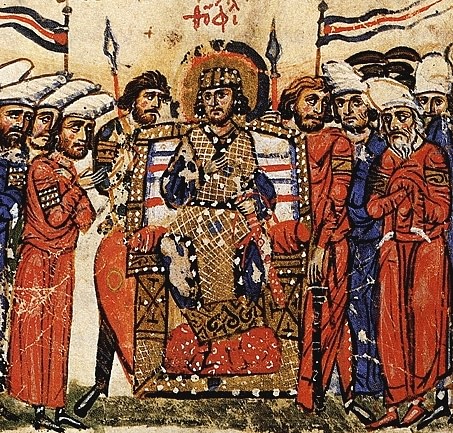
The government of the Byzantine Empire was headed and dominated by the emperor, but there were many other important officials who assisted in operating the finances, judiciary, military. and bureaucracy of a huge territory. Without elections, the ministers, senators, and councillors who governed the people largely acquired their position through imperial patronage or because of their status as large landowners. Government was multi-levelled based on the geographical division of the empire’s population and although corruption, rebellions, and invasions threatened the functioning of the system, and even caused its reduction in scale, the system nevertheless survived for centuries to become one of the most sophisticated apparatus of government seen in any empire in history.
THE EMPEROR
The Byzantine emperor (and sometimes empress) ruled as an absolute monarch and was the commander-in-chief of the army and head of the Church and government. He controlled the state finances, and he appointed or dismissed nobles at will, granting them wealth and lands or taking them away. The position was conventionally hereditary, but new dynasties were regularly founded as usurpers took the throne, usually military generals backed by the army. Unlike in the west, the Byzantine emperor was also head of the Church and so could appoint or dismiss the most important ecclesiastical role in the empire, the Patriarch or bishop of Constantinople. Further, the emperor was widely regarded as having been chosen by God to rule for the good of the people.
The emperor was distinguished by his magnificent royal residence, the Great Palace of Constantinople, and by his imperial regalia - the jewelled crown, belt, cloak, and brooch seen in so many depictions in Byzantine art. His or her image was widely seen as it appeared on coinage, official seals, weights, mosaics, and sculpture.
THE EMPEROR WAS SUPPOSED TO CONSULT THE SENATE & PARTICULARLY THE SMALLER GROUP OF THE MOST SENIOR SENATORS - THE SACRUM CONSISTORIUM.
Given the size of the empire and the complexity of all the different facets of government necessary for it to run smoothly, the emperor was, by necessity, obliged to consult with a team of close advisors. Such members of an inner circle at court, the comitatus, need not have held any formal position, but there were other permanent offices and positions which helped disseminate the imperial will to all corners of the empire. There were, in addition, the court eunuch chamberlains ( cubicularii ) who served the emperor in various personal duties but who could also control access to him. Eunuchs also held positions of responsibility themselves, chief amongst these being the holder of the emperor's purse, the sakellarios whose powers would increase significantly from the 7th century CE.
THE SENATE & IMPERIAL MINISTERS
The main forum of government was the Senate of Constantinople, which was made up of aristocratic males who were given their position by the emperor. Created by Constantine I (r. 306-337 CE), it was modelled on the Roman Senate. Although in practice the emperor could make any decision he wished, at least in theory he was supposed to consult the Senate and particularly the smaller group of the most senior senators known as the sacrum consistorium. This was especially so for matters of state importance - declarations of war, treaties of alliance, and so on. The Senate, therefore, was really only an advisory body. It could, though, function as the highest court in the land in rare cases of high treason. Leo VI (r. 886-912 CE) reduced the role of the Senate even further, but it would remain as an institution until the fall of the empire in the mid-15th century CE.
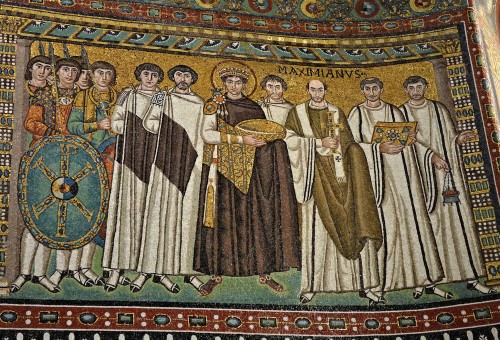
Empreror Justinian & His Court
Key ministers who reported to the emperor but had some autonomy of authority included the following:
- the quaestor sacri palatii or chief legal officer and head of the judiciary
- the magister officiorum who looked after the general administration of the palace, the army and its supplies, the secret police, transport, and foreign affairs
- the cursus publicus who supervised the public post
- the comes sacrarum largitionum who controlled the state mint ( Sakellion ) and supervised customs houses, the state workshops and armouries, and the state's gold and silver mines. He collected some specific taxes, paid out extraordinary bonuses to the army, and supervised the distribution of clothing to the court.
- the comes rei privatae who looked after the imperial estates and the emperor's personal wealth
- the praepositus sacri cubiculi or chief eunuch who typically controlled who could have a personal audience with the emperor
- the Urban Prefect or Eparch who was, essentially, the mayor of Constantinople and had to run the city, manage its prisons, ensure public order was maintained, supervise building projects, and organise public spectacles.
The emperor and the above officials were supported by various ministries and their heads ( domestikoi ) such as the head of orphanages ( orphanotrophos ) and the head of public records ( protasekretis ), as well as countless minor officials ( logothetes ) and archivists ( chartoularioi ).
REGIONAL GOVERNMENT
The Byzantine Empire was divided into the following territorial and administrative units:
- Prefectures (4)
- Dioceses (12)
- Provinces (100+)
- Town Councils
There were four prefectures, each governed by a Praetorian Prefect. The most important was the Praetorian of the East (the others governed Gaul, Italy and Illyricum) and, like his colleagues, he was responsible for all administrative, fiscal, and judicial affairs in his area. Prefects supervised and maintained the public post, roads, bridges, post-houses, and granaries in their area.
MEMBERS OF A COUNCIL OR CURIA WERE USUALLY THE WEALTHIER LOCAL CITIZENS, THE LAND-OWNING ELITE (ARCHONTES), WHO WERE NOT ELECTED.
The prefectures were further divided into dioceses with their respective governors ( vicarii ) and each of these into administrative provinces, each with its own governor who supervised the individual city councils or curiae. Cities which were the seat of a governor such as Ephesus, Sardis and Aphrodisias, flourished as the governors sought to leave lasting monuments in their city and support the culture there. This was usually to the detriment of smaller towns in the province, and there are even records of emperors admonishing governors for dismantling monuments and stealing the stones in lesser towns in order to beautify the provincial capital.
Members of a curia were usually the wealthier local citizens, the land-owning elite ( archontes ), and although there were no elections, the ordinary people could voice their opinions at public events by acclaiming or booing public figures, just as factions of the crowd at the Hippodrome of Constantinople sometimes did towards the emperor. Public opinion might not bring the dismissal of councillors or other government officials but it could affect their chances of promotion as the emperor and central government were always on the watch for signs of public unrest in the provinces. Riots did occasionally break out, and the damage and economic disruption they caused was best avoided.
Local councillors were responsible for all public services and the collection of taxes in their town and its surrounding lands (curiously, any shortfall had to be made up by the councillors themselves until that onerous obligation was abolished in the early 6th century CE). This was a deliberate policy by emperors to separate tax revenue from anyone holding positions of military power and, therefore, reduce the possibility that a usurper could fund that portion of the army he commanded against the state. The main tax was a land tax called the annona, which was calculated in consideration of a census ( indictio ) taken every 5, and then later, 15 years.
Local councils also had to help with national services such as providing horses for the empire's postal system. The local councils could directly petition the emperor so that there was both a direct and indirect chain of authority through which imperial policy was transmitted to the ordinary people. Leo VI abolished the councils in the 9th century CE, and their duties were redistributed to other officials. Finally, to ensure that government policy was carried through in practice, there was a whole army of imperial inspectors who were regularly dispatched to the provinces.
In the 7th century CE, as the empire shrank significantly and what remained became increasingly threatened by its neighbours. Emperor Heraclius (r. 610-641 CE), or his immediate successors, permanently changed the system of central government so that governors of the newly created large provinces or themes ( themata ) were now, in effect, provincial military commanders ( strategoi ) with civil responsibilities who were directly responsible to and reported to the emperor himself. The system of Praetorian Prefects was, therefore, abolished, and the logothetes, those minor officials looked down upon previously, became more instrumental in the successful running of the government and civil administration.
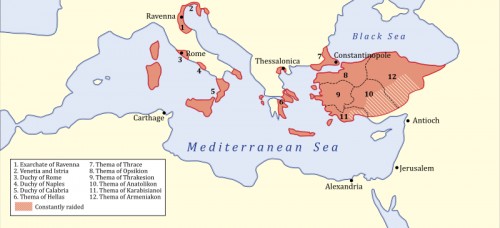
Byzantine Empire, 717 CE
Thus the whole bureaucracy was simplified and the number of officials massively reduced with the most important logothetesbeing:
- the logothetes tou stratiotikou who was in charge of military affairs from spending to armaments and supplies
- the logothetes tou genikou who was in charge of the land tax amongst many others
- the logothetes tou dromou who was in charge of foreign affairs, internal security, the public post, protection of the emperor, roads, and official public ceremonies.
In the 8th century CE, when armies of certain themes and strategoi posed a threat to the emperor's position, the themes were reorganised into smaller regional units to reduce their military power. By the 11th century CE, the theme system went into decline as emperors like Basil II (r. 976-1025 CE) preferred to rely on the greater loyalty of their own private army. The strategoi were gradually replaced by other officials with less overall powers such as the doux or katepano (military governor) and praitor (responsible for fiscal and judicial matters).
Similarities Between Eastern & Western Philosophy › Ancient History
Ancient Civilizations
Since the 'discovery' of eastern philosophy by western explorers and scholars in the 18th and 19th centuries CE, there has been an arbitrary division maintained, especially in colleges and universities, between 'western philosophy' and 'eastern philosophy' as though these two systems present radically different views of the world. There is no division between eastern or western philosophy when it comes to the most basic questions of what it means to be a human being. The fundamental purpose of philosophy is to find meaning in one's life and purpose to one's path, and there is no major difference between eastern and western philosophy according to that understanding.
THE PURPOSE OF HUMAN EXISTENCE
The similarities between eastern and western philosophy are greater than any differences cited by modern-day writers and lecturers on the topic. The most often cited difference is that western philosophy is 'fragmentary' while eastern philosophy is 'holistic'. The popular writer Sankara Saranam, author of the book God Without Religion, is one example of this when he claims that eastern philosophy is concerned with general knowledge while western philosophy aims at specific knowledge.This refers to the popular understanding that eastern philosophy - specifically Chinese philosophy - addresses the whole of human existence while western philosophy - beginning with the Greeks - only focuses on certain aspects of the human condition.
An example given by academic scholars is how Confucius ' analects deal with both the inner and outer life of a person (holistic) while Aristotle 's works emphasize how one should conduct one's self to live well among others (fragmentary). Mo-Ti, some claim, aims at a holistic understanding of one's self and one's surroundings while a western philosopher like Platoemphasizes specific goals one should strive for in discovering what is true and real in life.
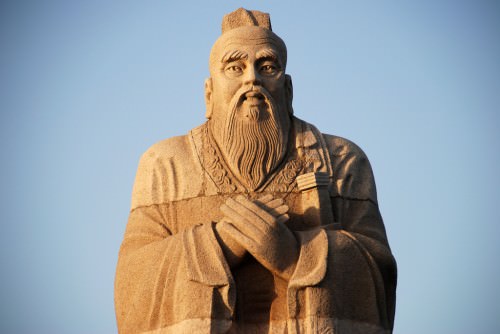
Confucius
These are arbitrary distinctions which totally miss the underlying, and essentially identical, aims of eastern and western philosophy. Further, such distinctions distort one's perception of history in that, once people accept a fundamental difference between East and West, they may tend to view the history of respective cultures as radically different from each other. In fact, human beings are essentially the same the world over, only the details and customs differ, and the philosophies of eastern and western thinkers make this quite clear.
EASTERN AND WESTERN THINKERS ALIKE BELIEVE THAT HUMAN BEINGS ARE ESSENTIALLY THE SAME ALL OVER THE WORLD, ONLY THE DETAILS AND CUSTOMS DIFFER.
One could compare the fundamental ideas of the great Chinese philosopher Confucius (551-479 BCE) with those of the Greekphilosopher Aristotle (384-322 BCE) and find they are presenting the same basic concepts. Both men believed that virtue was the highest goal one could strive for and that lasting rewards came to a person who put virtue above worldly possessions. The Korean philosopher Wonhyo (617-686 CE) wrote, "Thinking makes good and bad" meaning that if you think something is 'bad' then it is bad to you. The Greek philosopher Epictetus (c. 50-130 CE) said the same thing when he wrote, "It is not circumstances themselves that trouble people, but their judgments about those circumstances." ( Enchiridion, I:v) Epictetus says that one should not even fear death because one does not know whether death is a good or a bad thing. Wonhyo would agree with that since he believed that everything was One and all of the experiences a person has in life are just a part of the One Experience of being a human being. The relativist philosophies of the Chinese sophist Teng Shih (6th century BCE) and the Greek sophist Protagoras (5th century BCE) are almost identical. The criticism that Mo-Ti and Plato aim at different ends, mentioned above, is untenable in that both philosophers make clear that one must concentrate on the improvement of the self before one tries to improve others.
INNATE MORALITY
The best example, however, of the fundamental sameness of eastern and western thought is epitomized in the works of two of the best-known philosophers from their respective hemispheres: Plato (428-348 BCE) of the west and Wang Yangming (1472-1529 CE) of the east. While Plato is quite well known in the west, Wang Yangming is less so, even though he is as famous as Plato in China, Korea, and Japan. Both of these philosophers have exerted an enormous influence through their works, and both argue for the existence of innate knowledge; that human beings are born knowing right from wrong, and good from bad, and need only be encouraged to pursue goodness in order to live a fulfilling life. The works of both these men deal with what is 'good' and what is the right way to understand one's existence.
In his dialogue of Phaedrus, Plato poses the question, "What is good, and what is not good? Need we ask anyone to tell us these things?" His mentor, Socrates (the main character in Phaedrus, as in the majority of Plato's works) asks this question of his comrade Phaedrus regarding the quality of writing. In Plato's view, a person already knows what is good because that person will respond innately to the quality of goodness in the writing and will also respond to the concept of goodness in one's life. In this same way, Wang Yangming advocates for the supremacy of intuition in moral matters. Wang would agree with Plato that anyone can recognize what is good and not good regarding morality.
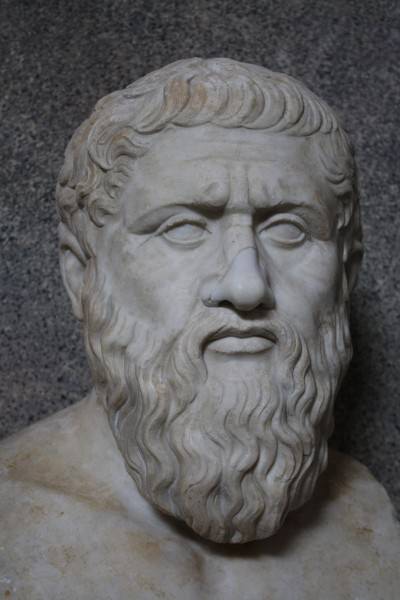
Plato
Wang's and Plato's philosophies have been attacked by empiricists for a lack of evidence, but what these two philosophers are contending makes sense on a very basic level: one must know what is good in order to pursue what is good, and this knowledge of the good must be innate in order for people to have the desire to pursue it in the first place. Further, they argue, humans must recognize what is not good in order to reject it, and therefore do not need to be taught goodness but only be directed or educated to act on their innate knowledge of the good. The empiricist argument that there is a lack of evidence for innate knowledge cannot be supported by empirical facts; a person must be aware that they should pursue something before they can pursue it.
Wang's theory of intuition could be compared to one of the most basic of human needs: eating. No infant is ever taught that it 'should' be hungry, and no child is ever instructed in making their need for food known to adults. The infant cries to let an adult know that it must be fed, and the child verbalizes that same need in words or deeds, such as saying, "I am hungry," or going to get something to eat. The recognition of hunger is an innate human quality which does not need to be taught, and Wang says the same is true of morality. All that must be taught is how to apply that innate knowledge appropriately, in the same way that a child is taught the appropriate way to ask for food.
In Plato's Meno, Socrates praises a slave who knows geometry although he has never been taught it. Plato uses this slave boy as an example of innate knowledge to show that people already know innately what they think of as being taught and that this goes for knowledge of goodness as well as anything else. Just as a child knows when it is hungry, a person knows how to be good. Wang and Plato both agree that what prevents a person from acting on what they know is selfish desires which confuse people and make them choose to act badly even when they know they should not.
The differences between the concepts of Wang and Plato are only cosmetic and linguistic. There is no difference in their fundamental ideas. Philosophers from the east have always been engaged in exactly the same pursuit as their counterparts in the west. There is no 'eastern' or 'western' philosophy; there is only philosophy. The love of wisdom knows no separate region;philosophy defies all boundaries and every kind of petty regional definition.
LICENSE:
Article based on information obtained from these sources:with permission from the Website Ancient History Encyclopedia
Content is available under License Creative Commons: Attribution-NonCommercial-ShareAlike 3.0 Unported. CC-BY-NC-SA License